Abstract
The Thomas–Fermi model and its quantum and exchange corrections with mathematic manipulations and numerical approaches are primarily investigated. The reduced ideal electron chemical potential is adopted as the initial value for the iterative solution of the Thomas–Fermi model. A new transformation for the quantum and exchange equations is proposed to apply the boundary conditions easily. Both the Thomas–Fermi equation and correction equations are solved with the Runge–Kutta algorithm. The mathematical difficulties in controlling the computing accuracy of the equations containing the Fermi–Dirac integral are settled. The equation of state, based on the Thomas–Fermi model with its quantum and exchange corrections, is constructed and compared with relevant data.
1. Introduction
The Thomas–Fermi (TF) model was initially developed to study the electron distribution of the multi-electron atom [1,2]. Since its advent, this model has been being widely used in solid state physics [3], atomic physics, astrophysics, and equation of state computations [4]. It is particularly important for describing the behavior of matter under extreme conditions of high temperature and high density. The TF model provides relatively accurate results validated by experimentally measured pressure data [5]. However, the investigations available for the early stage almost entirely focus on the properties of the zero-temperature TF model. Under the conditions of relatively low temperature and small volume, it is treated as a perturbation from the zero-temperature TF model, which is limited within the region of the large positive work function [6]. To overcome the disadvantages of the above-described temperature perturbation theory, Latter made great efforts to provide a description of the temperature-dependent behavior of the TF model [6]. The TF model yields a pressure value that is a few GPa under the normal density, even at very low temperatures. The predicted pressure is always positive, indicating an obvious limitation of this model [7]. The electron exchange correction originating from the Pauli principle on the interaction of the particles was introduced into the zero-temperature TF model by Dirac [8]. However, the correction is still not large enough to reduce the energy and pressure to a reasonable level. Kompaneets and Pavlovskii have shown that the quantum correction corresponding to the approximate character of the semi-classical description of the TF model must be taken into consideration [9]. Kirzhnits has evaluated the influence of quantum effect and exchange effect on the temperature-dependent TF model and their contributions to the equation of state [10]. The TF model with its quantum and exchange corrections (TFC model), which has substantially lower pressure than that estimated for the TF model, can be applied to calculate the thermal contribution of the electrons.
Although the TF and TFC models have a wide range of applications, the key problem is the theoretical calculation of the models, involving considerable numerical work and mathematical obstacles [11]. Furthermore, there are different forms of complicated equations for the quantum and exchange correction models [9,10,12]. Compared with the TF model, numerical investigations on the quantum and exchange correction equations are still relatively scarce. Therefore, it is necessary to provide more concise descriptions of the numerical solving approaches for the TFC model.
In this paper, the TF model and its quantum and exchange corrections are outlined. The fourth-order Runge–Kutta method is adopted to solve the TF equation. The calculation method for the reasonable initial value of the iteration is presented. A more simple and effective iterative relation is deduced from the integral form of the TF equation. The equations of correction models are solved with the Runge–Kutta method based on the solution of TF equation. A new mathematic manipulation with the advantage of using the boundary conditions is proposed to solve the equations of the correction models. The equation of state, based on the TF and TFC models, is presented. The calculated results are also compared with relevant experimental results. With respect to the Fermi–Dirac integral, the cutoff function is calculated with a certain given truncation error based on the infinite integral truncation method. A method is proposed to treat this kind of integration with singularity at zero-point temperature. This paper contributed to the research on exploding wire numerical simulations, in which the TFC model can be used to approximate the metallic wire’s transition from the solid state to the plasma state [7,13,14]. The results described in this paper correspond to the widely used element of aluminum (Al) in the research and application of exploding wires.
2. Thomas–Fermi Model and Its Numerical Solution
The TF model is applied to the confined atoms, consisting of ions and free electrons enclosed in a sphere without penetration of the neighboring atoms. The electrons follow the Fermi–Dirac distribution in a potential field governed by Poisson’s equation. Then, the TF equation, as shown in Equation (1), can be derived from Poisson’s equation and the Fermi–Dirac distribution [6,15],
in which, a = (r0πe(2me)3/4(kT)1/4/h3/2)2, r0 is the equivalent radius of an atom calculated by r0 = (3A/4πρNA)1/3, x = r/r0, and x ϵ (0, 1). φTF is the dimensionless electron potential, defined as φTF = (μ + eV(r))/kT; μ is the electron chemical potential; V(r) is the electron potential; e is the electron charge; me is the electron mass; A is the atomic weight; ρ is the mass density; T is the temperature; and k is the Boltzmann constant. h is the Planck constant, and NA is the Avogadro constant. Fj is the Fermi–Dirac integral of order j, defined by the following formula:
The atomic system is neutral so that the potential is zero on and beyond the boundary of the isolated atom [6]. On the other hand, the potential has singularity at the center of the atom, with a positive charge of +Ze (Z is atomic number). Therefore, the boundary conditions of Equation (1) are
The Runge–Kutta algorithm is adopted to solve Equation (1). The Fermi–Dirac integral F1/2 changes rapidly in the neighborhood of the atom center, where the nonlinear degree of the TF equation becomes higher. Therefore, the variable substitution of y2 = x is proposed to improve the solution near x = 0. The second-order partial differential equation is reduced to a set of first-order partial differential equations, as shown in Equation (5). The system of equations can be solved with an assumed initial value of φTF (1). Since φTF (0) is calculated by the boundary condition shown in Equation (3), the equations can be iteratively solved by adjusting the value of φTF (1) until a converged solution of φTF (0) is achieved.
It should be noted that the adjustment of φTF(1) is based on the monotonic relation of φTF(x) ∝ φTF(1). The relationship between φTF(x) and φTF(1) is expressed as Equation (6), which is derived by double integration of Equation (1) with the boundary condition of Equation (4).
The selection of the initial value φTF(1) is very important for the iteration process. Overflow in computing might occur during the iteration if the initial value φTF(1) is too large. On the contrary, a small initial value consumes much computing time. Therefore, a suitable initial value of φTF(1) is important for saving time and ensuring fast convergence. From the physics of the TF model, one can see that φTF(1) = μ/kT, which is denoted as the reduced electron chemical potential η = μ/kT. It is reasonable to take the ideal electron chemical potential as the initial value for the iteration. The initial value φTF(1), i.e., the reduced ideal electron chemical potential η, is calculated by means of the well-known relation between Equations (2) and (7) [15,16]:
in which λe = h/(2πkTme)1/2, and ne is the electron number density. The ionization model consisting of a smooth blending between the TF ionization model and Saha equation in the single-ionization regime is adopted to calculate the electron number density [17]. The dimensionless electron potential φTF(x) of the TF model, calculated by Equation (5) for the element aluminum (Al), is shown in Figure 1, with density ρ = 0.5 g/cm3 and temperature T = 1 eV.
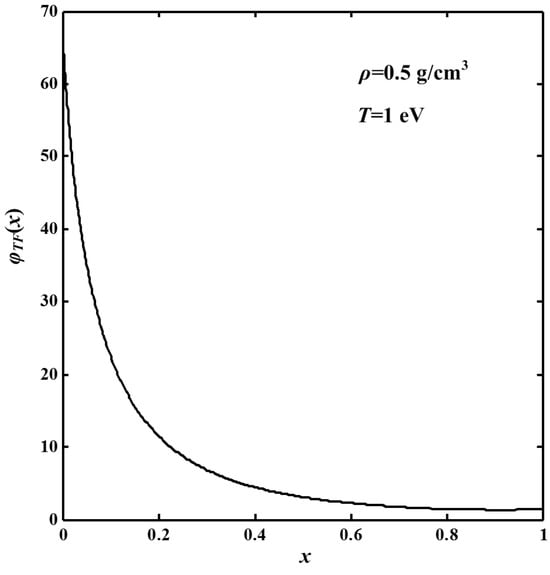
Figure 1.
The dimensionless electron potential distribution for Al.
3. Quantum and Exchange Corrections and Its Numerical Solution
The TF model is based on the Fermi–Dirac statistics applied to electrons. The coulomb interaction between atomic nucleus and degenerate electrons within an atom is considered. It is well known that this model is successful in the region of high pressure. However, it has a limitation under certain conditions, in which the quantum and exchange effects are significant [18]. The TF model has undergone many corrections to improve its accuracy for calculation of the equation of state [19]. The correction from the exchange interaction of the electrons introduced by Dirac results in the TFD model [8]. The quantum mechanical description of the electron is another primary correction to the basic TF model [10]. Kirzhnits further introduced the quantum correction, which is important in the high-electron gradient region [9].
It is assumed in the TFC model that φ = φTF + δ1φ + δ2φ, where δ1φ and δ2φ are the quantum and exchange corrections for the electron potential, respectively. A variable, ξ = φ/x, is defined to simplify the correction equations. Then, ξ = ξTF + δ1ξ + δ2ξ is derived according to the definition of ξ. The correction terms of δ1ξ and δ2ξ can be obtained by solving Poisson’s equation with an approximated expression of the density [9]. The derived correction equations are expressed as follows [12]:
in which θ = a0kT/e2Z4/3, and a0 = h2/4π2mee2 is the Bohr radius. Taking the following notation changes,
the quantum and exchange correction equations are transformed into the following formulas [9,12]:
The boundary conditions are xui|x→0 = 0 and u′i(1) = 0 (i = 1, 2). It should be noted that variable change ψi = x2ui is applied to solve Equations (12) and (13). In this approach, a complicated process of estimating ui(0) has to be carried out. In this paper, in order to get an easier mathematics manipulation of the boundary conditions, a new relation, ψi = xui, is proposed. Therefore, ui(0) = ψi′(0). Substituting ψ into Equations (12) and (13) yields the following equations:
The boundary conditions are ψi(0) = 0, ψi′(1) = ψi(1).
In addition, in order to improve the solution near x = 0, the transformation of y2 = x is adopted as the manipulation of the TF equation. The quantum and exchange correction equations are also solved using the Runge–Kutta method. The quantum and exchange corrections of the electron potential calculated by the above formulas at density ρ = 0.5 g/cm3 and temperature T = 1eV are shown in Figure 2.
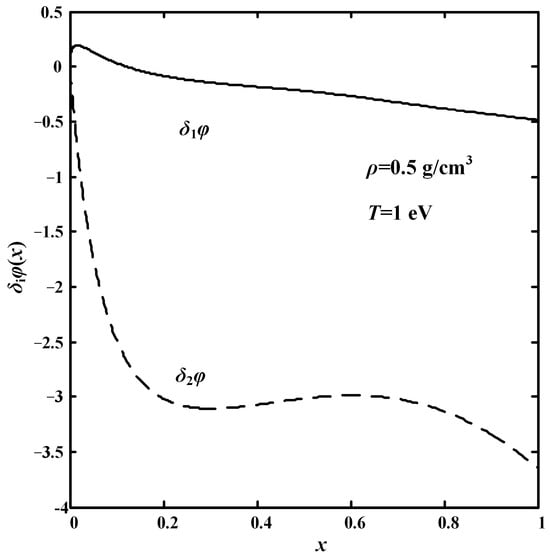
Figure 2.
The quantum and exchange corrections of dimensionless electron potential.
4. Application of the TFC Model in Constructing Equation of State
In the condensed states of solid and liquid phases, the material remains virtually stationary and holds together as a whole. The electrons under such conditions do not behave as a perfect gas. The quantum and exchange effects act as a binding force applied to electrons so that much less pressure is released. Even in the high-density vapor state with low temperature, the pressure of electrons are substantially small with respect to the value of the perfect gas [7]. In this connection, the TF model with quantum and exchange corrections allows the condense phase to be approximately modeled.
The pressure of the TF model is expressed as the rate of momentum transfer between the electrons and the atomic boundary [6]. The expression of the pressure is shown in Equation (16):
The quantum correction to the pressure is obtained by expanding the corrected TF pressure for the uncorrected potential to the first order. The pressure corrected by the quantum effect is simplified as follows [9]:
The exchange correction to the pressure calculated from the exchange contribution to the momentum transfer to the atomic boundary is expressed as follows [9]:
And the total pressure of the TFC model is P = PTF + δ1P + δ2P. The kinetic energy of the TF model is calculated from the integration of the kinetic energy per electron multiplied by the density of electron over momentum and volume of an atom [6]. The result is expressed in notation from as
And the potential energy is derived from the Virial theorem. The potential energy of the TF model is expressed as follows:
where V is the equivalent volume of the isolated atom. The total energy of the TF model is ETF = Ekin + Epot − E∞. E∞ is calculated from the zero-temperature TF model under the condition of the isolated atom [12].
The quantum and exchange corrections to the energy of the TF model are expressed as follows:
where b = (2me)1/2e2/(3h(kT)1/2). The total correction of energy is δE = δ1E + δ2E + δE∞; δE∞ is the energy correction reference, also calculated from the zero-temperature TF model of an isolated atom. Then, the energy of the TFC model is E = ETF + δE.
The metallic wire driven by the pulsed current experiences severe phase transitions, from solid state to liquid state, gas state, and even to the plasma state. Therefore, the behavior of the electrons from the TFC model is calculated within the typical temperature density domain corresponding to the exploding wires. The pressure values, dependent on the temperature and density derived from the TF model and TFC model, are shown in Figure 3. The results from Ref. [9] are also plotted for comparison. The temperature is scaled with the relation kT/Z4/3.
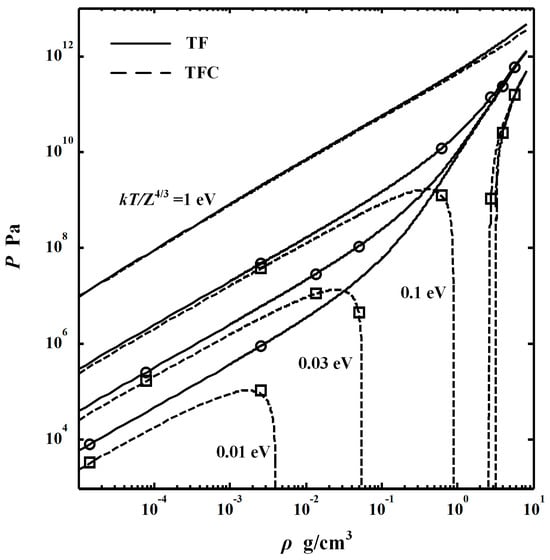
Figure 3.
The pressure derived from the TF and TFC model as a function of temperature and density. The data presented by squares and circles are from Ref. [9].
It can be seen from Figure 3 that the pressure increases with temperature. The TF model predicts positive values even at relatively low temperature, causing the simulation to expand the trajectory of the metallic wires, deviating from the experimental measurements. The quantum and exchange corrections substantially lower the pressure of the TF model, especially in the region of sub-solid density and low temperature. The contributions of quantum correction and exchange correction on the pressures are comparable in the region of sub-solid density. The effect of both quantum and exchange corrections decreases with the increase in temperature and become negligible at kT/Z4/3 = 1 eV. The present results are in relatively good agreement with the results of Ref. [9].
The dependence of energy per atom with density and scaled temperature is shown in Figure 4. One can see that there is a distinct difference to the relation presented in Figure 3. The energy of the TFC model is higher than that of the TF model in the low-density region. The quantum and exchange correction lower the energy of the TF model with the increase in density. The energy is also much reduced in the region of sub-solid density. The correction effect decreases with the increase in the temperature.
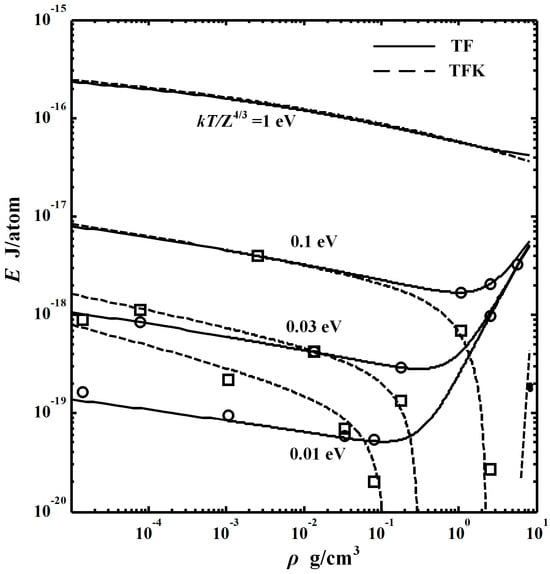
Figure 4.
The energy of the TF and TFC model as a function of temperature and density. The data presented by squares and circles are from Ref. [9].
The pressure and energy are substantially reduced by the quantum and exchange corrections in the region of sub-solid density at low temperature. This is evidence of the binding force of the electrons holding the condensed matter together. It seems that the energy of the TF model near the sub-solid density region at low temperature is over corrected. This is due to the nature property of the TFC model, in-depth research on which is beyond the scope of this research. These results are useful in taking into account the thermodynamic contribution of electrons in the construction of a wide-range semi-empirical equation of state.
5. Mathematical Treatments with Fermi–Dirac Integral
The Fermi–Dirac integral appears frequently in the equations of the TF model and its quantum and exchange correction models. Furthermore, it is also widely used in a variety of fields, such as thermionic emission, the theory of metals, and semiconductor-related fields [20]. Therefore, rapid and accurate calculation of the Fermi–Dirac integral is a key problem in the solution of the TFC model. The traditional method is the polynomial approximation [20,21]. However, in some cases, it is necessary to control the accuracy of results with acceptable computing time. Thus, the method of infinite integral truncation is adopted to calculate the Fermi–Dirac integral with a certain given truncation error O. In the case of order j = 1/2, Equation (2) can be split into the integral primary term D(z) and the remainder term R(z), as shown in the following equations:
in which f(z) is the truncation value function.
It is proven that f(z) ϵ (1, + ∞) led to an easy transformation of R(z), and this assumption had no influence on the required accuracy [22]. It is assumed that the integral remainder term satisfies the relation of R(z) ≤ O. Substituting the relation into Equation (25), the inequality of f(z) is derived as shown in Equation (26):
Here, we take the integral remainder term O = 4.5e−5 as an example. Fitting the boundary of the inequality Equation (26), we can get the truncation value function f(z) = −0.0009z2 + 1.0718z + 12.5242. Then, the Fermi–Dirac integral F1/2(z) approximately equals the integral primary term D(z) with given truncation error. The numerical result of D(z) is in good agreement with the results calculated by the polynomial approximation, as shown in Figure 5.
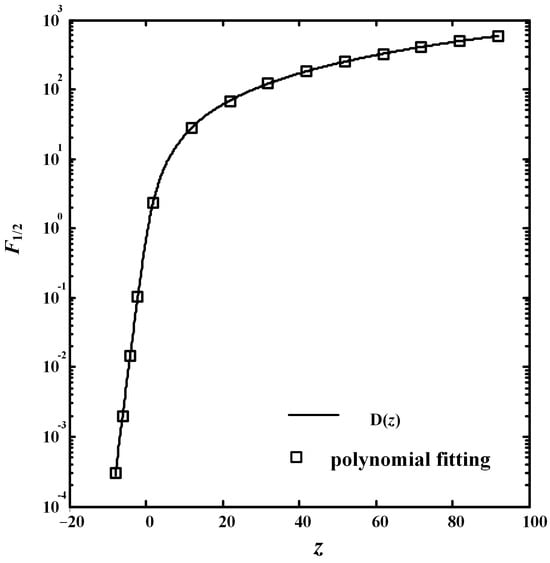
Figure 5.
The numerical result of the Fermi–Dirac integral F1/2.
Many Fermi–Dirac integrals of different order j (j = 1/2, 3/2), as well as their first- and second-order derivatives, are used in TF models and their quantum and exchange models. They are calculated by the relation of F′j(z) = jFj-1(z).
A mathematical barrier caused by the Fermi–Dirac integral emerges in the calculation of energy in the TF and TFC models. If a Fermi–Dirac integral has singularity, it is difficult to obtain an accurate result. Taking Equation (19) as an example, the integral domain is x ϵ (0, 1). One can see that if x tends to be zero, then the integrand x2F3/2(φTF(x)/x)|x→0 = ∞. The accuracy of the results for Equation (19) cannot be satisfied by using the normal numerical integral method while ensuring acceptable computing consumption. Thus, the method of integral domain division is employed. The proposed integral process is shown in Figure 6. The integral domain (0, 1) is divided into (0, x1] and (x1, 1). The integral S1 is conducted with Cotes formula in the interval (x1, 1), in which singularity is excluded. Then, the surplus interval (0, x1] is subdivided into two subintervals (0, xm1] and (xm1, x1). The integral Sm1 is calculated in the interval (xm1, x1). The process continues until the integral Smi is smaller than the required accuracy.
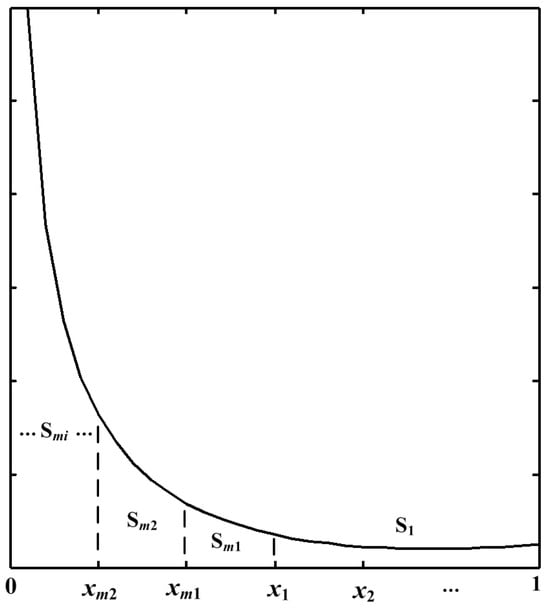
Figure 6.
The schematic diagram of the integral process with singularity at zero.
6. Conclusions
In this paper, numerical investigations characterizing the TF model with quantum and exchange corrections are presented. The initial value for the iteration, which is calculated by the ideal electron chemical potential, as well as the iteration relation, is proposed to ensure fast computing and easy convergence of the TF equations. A new transformation of the quantum and exchange equations, with the advantage of making use of the boundary conditions, is proposed. The Fermi–Dirac integral is calculated by the method of infinite integral truncation with controlled accuracy. A kind of integral with singularity, which arises in the calculation of the equation of state, is settled with an easy-to-understand and easily calculable algorithm. The equation of state based on the TF model and TFC model is described. The pressure and energy of the TF model are substantially reduced by the quantum and exchange corrections in the region of sub-solid density and low temperature, which is particularly important in describing the phase transition of solid metals. This can be adopted as the thermal contribution of the electrons to the thermodynamic functions.
Author Contributions
Conceptualization, K.W. and Y.M.; methodology, K.W. and W.S.; software, Y.M., W.S. and K.W.; validation, K.W., J.Z. and W.S.; formal analysis, L.W. and K.W.; investigation, K.W.; resources, S.M. and K.W.; data curation, K.W.; writing—original draft preparation, Y.M.; writing—review and editing, K.W. and Y.M.; visualization, S.M. and K.W.; project administration, K.W.; funding acquisition, K.W. and W.S. All authors have read and agreed to the published version of the manuscript.
Funding
This research was funded by State Grid Hebei Electric Power Co., Ltd., grant number No. kj2023-012.
Institutional Review Board Statement
Not applicable.
Informed Consent Statement
Not applicable.
Data Availability Statement
The original contributions presented in this study are included in the article. Further inquiries can be directed to the corresponding author.
Conflicts of Interest
The authors Yangyang Ma, Wenle Song, Junlei Zhao, Lei Wang and Shenghui Mu are employed by State Grid Cangzhou Electric Supply Company while contributing to this manuscript. Their contributions to this work and manuscript were made independently without any requirement, guidance or input by the employer. They received no financial compensation from any source for the contributions they made to this scientific work and manuscript. The funders had no role in the design of the study; in the collection, analyses, or interpretation of data; in the writing of the manuscript, or in the decision to publish the results
References
- Thomas, L.H. The calculation of atomic fields. In Mathematical Proceedings of the Cambridge Philosophical Society; Cambridge University Press: Cambridge, UK, 1927; Volume 23, pp. 542–548. [Google Scholar]
- Fermi, E. Eine statistische Methode zur Bestimmung einiger Eigenschaften des Atoms und ihre Anwendung auf die Theorie des periodischen Systems der Elemente. Z. Für Phys. 1928, 48, 73–79. [Google Scholar]
- Slater, J.C.; Krutter, H.M. The Thomas-Fermi method for metals. Phys. Rev. 1935, 47, 559. [Google Scholar]
- Shemyakin, O.P.; Levashov, P.R.; Khishchenko, K.V. Equation of state of al based on the Thomas-Fermi model. Contrib. Plasma Phys. 2012, 52, 37–40. [Google Scholar]
- Salzmann, D. Atomic Physics in Hot Plasmas; Oxford University Press: New York, NY, USA, 1998. [Google Scholar]
- Latter, R. Temperature behavior of the Thomas-Fermi statistical model for atoms. Phys. Rev. 1955, 99, 1854. [Google Scholar]
- Chittenden, J.P.; Lebedev, S.V.; Ruiz-Camacho, J.; Beg, F.N.; Bland, S.N.; Jennings, C.A.; Bell, A.R.; Haines, M.G.; Pikuz, S.A.; Shelkovenko, T.A.; et al. Plasma formation in metallic wire Z pinches. Phys. Rev. E 2000, 61, 4370. [Google Scholar]
- Dirac, P.A.M. Mathematical Proceedings of the Cambridge Philosophical Society; Cambridge University Press: Cambridge, UK, 1935; Volume 26, p. 376. [Google Scholar]
- McCarthy, S.L. The Kirzhnits Correction to the Thomas-Fermi Equation of State; UCRL-14364; Lawrence Radiation Laboratory Report: Berkeley, CA, USA, 1965. [Google Scholar]
- Kirzhnits, D.A. Quantum corrections to the Thomas-Fermi equation. Sov. Phys. JETP 1975, 5, 64. [Google Scholar]
- Shemyakin, O.P.; Levashov, P.R.; Obruchkova, R.L.; Khishchenko, K.V. Thermal contribution to thermodynamic functions in the Thomas-Fermi model. J. Phys. A Math. Theor. 2010, 44, 335003. [Google Scholar]
- Xu, X.S.; Zhang, W.S. A Practical Introduction to the Theory of Equation of State; Since Press: Beijing, China, 1986. [Google Scholar]
- Tkachenko, S.I.; Gasilov, V.A.; Ol’khovskaya, O.G. Numerical simulation of an electrical explosion of thin aluminum wires. Math. Models Comput. Simul. 2011, 3, 575. [Google Scholar]
- Sarkisov, G.S.; Rosenthal, S.E.; Cochrane, K.R.; Struve, K.W.; Deeney, C.; McDaniel, D.H. Nanosecond electrical explosion of thin aluminum wires in a vacuum: Experimental and computational investigations. Phys. Rev. E 2005, 71, 046404. [Google Scholar]
- Shi, Z.Q.; Wang, K.; Li, Y.; Shi, Y.J.; Wu, J.; Jia, S.L. The calculation of electron chemical potential and ion charge state and their influence on plasma conductivity in electrical explosion of metal wire. Phys. Plasmas 2014, 21, 032702. [Google Scholar]
- Apfelbaum, E.M. Calculation of electronic transport coefficients of Ag and Au plasma. Phys. Rev. E 2011, 84, 066403. [Google Scholar]
- Desjarlais, M.P. Practical improvements to the Lee-More conductivity near the metal-insulator transition. Contrib. Plasma Phys. 2001, 41, 267–270. [Google Scholar]
- Kirzhnits, D.A.; Yurii, E.L.; Galina, V.S. Statistical model of matter. Sov. Phys. Uspekhi 1975, 18, 649. [Google Scholar]
- Spruch, L. Pedagogic notes on Thomas-Fermi theory (and on some improvements): Atoms, stars, and the stability of bulk matter. Rev. Mod. Phys. 1991, 63, 151. [Google Scholar]
- Chang, T.Y.; Izabelle, A. Full range analytic approximations for Fermi energy and Fermi-Dirac integral Ғ1/2 in terms of Ғ1/2. J. Appl. Phys. 1989, 65, 2162. [Google Scholar]
- Antia, H.M. Rational function approximations for Fermi-Dirac integrals. Astrophys. J. Suppl. 1993, 84, 101. [Google Scholar]
- Liu, Q.; Ding, N. A practical numerical method for Fermi-Dirac integrals and applications. J. Numer. Methods Comput. Appl. 2004, 1, 74. [Google Scholar]
Disclaimer/Publisher’s Note: The statements, opinions and data contained in all publications are solely those of the individual author(s) and contributor(s) and not of MDPI and/or the editor(s). MDPI and/or the editor(s) disclaim responsibility for any injury to people or property resulting from any ideas, methods, instructions or products referred to in the content. |
© 2025 by the authors. Licensee MDPI, Basel, Switzerland. This article is an open access article distributed under the terms and conditions of the Creative Commons Attribution (CC BY) license (https://creativecommons.org/licenses/by/4.0/).